Heating schemes with double-boiler: the most appropriate
As you know, dual-circuit heating in a house is when the heat generator separately warms the water for radiators (first branch) and for hot water supply (second branch). A similar scheme of the system in our days has become quite popular, because of its versatility and comfort.
In order for such a network to function, first of all, a dual-circuit heating boiler is needed, which is able to heat both heat transfer fluid and hot water. We will describe how a private house with a double-circuit boiler can be implemented in this article.

Features of double circuit heat generators

- The main difference between such units and single-circuit counterparts is that they use the heat energy of the fuel not only to heat water in the heating circuit, but also in the branch for hot water supply.
- Single-circuit counterparts can also be used to heat water.. This can occur in the storage tank by indirect heating. In this case, the heat carrier will partially give up energy, flowing through an additional heat exchanger in a thermally insulated tank.
- The main difference of the factory bypass unit from such homemade circuits is the direct transfer of heat energy from the fuel to the water..
Note! When designing a system, consider one very important feature that a heating scheme with a double-circuit boiler has. When the house includes a hot water faucet, the boiler stops heating the coolant and switches to the DHW circuit.
How does such a unit work in practice?

- For well-insulated buildings with a significant area, the sounded mode of operation of the double-circuit unit is not very important. Such buildings have high thermal inertia. Therefore, even when the boiler heats water for a couple of hours only for household needs, the temperature in the house will change only by 1/2 degree.
- When a building is small or not sufficiently insulated, inertia becomes an important parameter. Heating batteries and water in the pipes in this case should cool as long as possible. This can be achieved by picking up radiators with a large volume of sections and pipes with an increased section.
- When there is a need for significant volumes and constant costs of hot water, it is better not to install a double-circuit boiler.
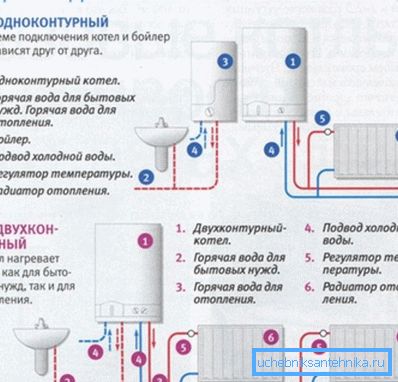
Here the heating scheme with two boilers of either a single-circuit analog and a column heating water is better. The double-circuit unit will not be able to maintain a comfortable temperature in the premises if a larger percentage of the time is used on the DHW.
- A gravity heating system should also not be planned with a similar boiler.
Note! In this case, after stopping the boiler, the circulation in the heating network will stop almost immediately. Its recovery will be long. During refilling with hot water, the batteries will heat up unevenly. This will lead to an uncomfortable temperature distribution in the rooms.
Heating arrangement if the building is small
Let us consider what the scheme of strapping of a double-circuit heating boiler can be if the house is one-storeyed, small (up to 100 m2) and has several separate rooms that all need to be heated.
In this case, the one-pipe network will be optimal. It is the simplest in construction and installation, with its operation almost no problems. In addition, the price of the system will be low, due to the economy of materials, because they will take less than a two-pipe counterpart.
Schema implementation
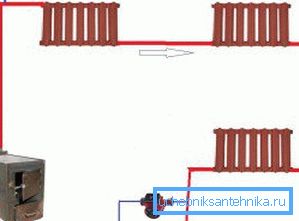
- A small volume of the building suggests that there will be few tenants in it. So the cost of hot water will be small. There is no need to abandon having unimportant inertia, but beautiful and well-giving heat aluminum batteries. Pig-iron analogs are heat-sensitive, but, as a rule, non-aesthetic.
- The volume of coolant in the pipes, in this case, it is recommended to increase. The optimal solution to the problem is to increase the cross-section of products by one row. For example, from Du-30 to Du-40. The amount of water in the circuits will then become 1.6 times larger.
- All radiators need to be mounted, without opening the circuit, parallel to it. The scheme of their tie-in can be diagonal or lower.
The instruction recommends to put on each battery:
- throttle (feed balancing);
- shut-off valve on the return pipe;
- valve for air bleeding from the system (conventional design or Mayevsky) to the right or left upper cap.
Lower wiring option
- To reduce the cross-section of the main circuit and open it, in this case, should not be.
- Immediately after the heat generator, the contour pipe must be sharply raised vertically to create an “accelerating” collector. Then you need to lead it with a slope (constant) down.
Note! Such pipe routing is quite complex and unaesthetic. However, it is necessary that when the pump is turned off, the heating batteries are heated due to natural circulation.
- In front of the boiler (along the flow of coolant) should be installed expansion tank (diaphragm). It will compensate for the increase in the volume of water when it is heated.
- The tank should have a capacity of 10 percent of the volume of the heat carrier. The tank should be put up liner.
What to do if the house is large in size
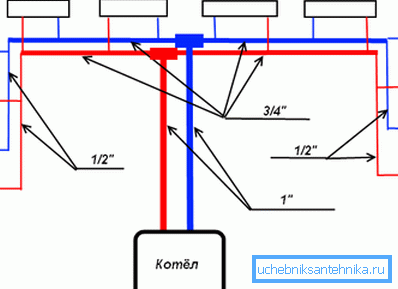
- For a large two-story building with a large number of separate rooms, the two-pipe heating scheme is best suited. It should have a top filling and constant wiring radiators.
- Straight from the heat generator, the heated water flows upward through the supply pipe. It goes around the building in its attic or ceiling of the upper floor.
- Then the water gets into the risers, the batteries are connected to them. They do not completely open the riser. Each device is equipped with an adjusting choke and jumper.
- It is advisable to install a shut-off valve on the second branch of the inlet pipeline. The valve for air bleeding can be put only one and fastened to the expansion tank in the upper part of the circuit.
- On the second (lower) pipe, which bends around the building through the basement or the floors of the first floor, water flows back to the boiler.
Note! Such binding of a double-circuit heating boiler has one important advantage. If necessary, it is able to function due to the natural circulation of the heat carrier. A pipe for the flow of water to the upper part of the bottling will act here as an accelerating collector.
That is, a system with such a scheme can operate without power-dependent units (for example, a pump). Based on this, if force majeure arises, you will never freeze.
Increasing the thermal inertia of the system
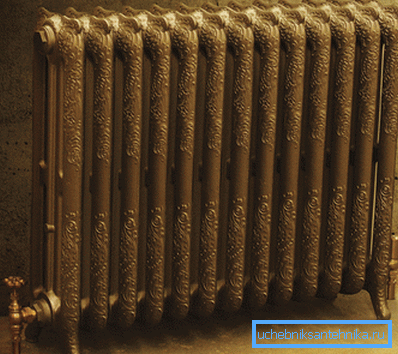
You can increase the thermal inertia of the heating system with your own hands.
- It is convenient to do this by choosing a slightly larger section of the contour pipes than is necessary for the project.
- You can also replace aluminum batteries with cast iron counterparts. They have an expanded internal volume of sections, which increases the thermal conductivity and heat capacity of the material. It is believed that all cast iron batteries for heating systems have an ugly design. However, it is not. Yes, their obsolete Soviet-era models are still being produced. But besides them, the market offers modern counterparts. For example, beautiful floor radiators from forged cast iron or wall batteries with flat aesthetic shapes.

- Often, the attic or second floor of a house in winter is needed only occasionally, for example, to accommodate guests. Then the best option is to use a heating scheme with two heat generators and separate single-pipe circuits for each floor.
- In this case, at the top, the boiler will be operated most of the time in economy mode, i.e. maintain a temperature of about +5 degrees.
The cheapest way to overcome all problems.

- You can independently improve the heating network, many times increasing its thermal inertia.
- To do this, add to the circuit a battery of thermal energy (storage tank). It is a container with a volume of 300/2000 l, which has two connecting pipes. The tank should be well insulated to reduce heat loss.
- Capacity serves for accumulation of large volumes of heated water. If the boiler stops, then the heat is spent from this tank. It is clear that the larger the reservoir, the slower the radiators will heat up.
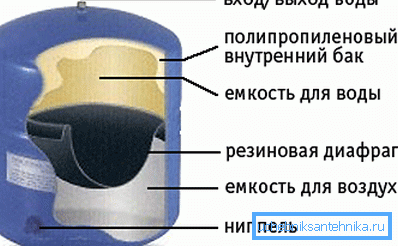
- The heat accumulator can be put on any of the sections of the heating system. You can mount it in the basement. To do this, open the lower circuit with two connections. It is possible to put the unit in the pantry. An interesting option is to turn the device into the basis of a warm stove bench. After all, it will inevitably give some heat to the atmosphere.
- The battery will compensate for temperature drops in the coolant during the period when the boiler warms the water for hot water supply. It is very beneficial if the boiler is powered by electricity.
Note! Of course, this method has its drawbacks. For example, a heat accumulator is quite expensive. A high-quality insulated model, having a volume of one cubic meter, will cost you 20/30 rubles, which depends on the manufacturer.
Conclusion
The double-circuit heat generator has both its advantages and disadvantages. If desired, the minuses of the unit can be significantly reduced. In this case, you will get the most comfortable system that will provide your home with both hot and warm water. The video will tell you even more.